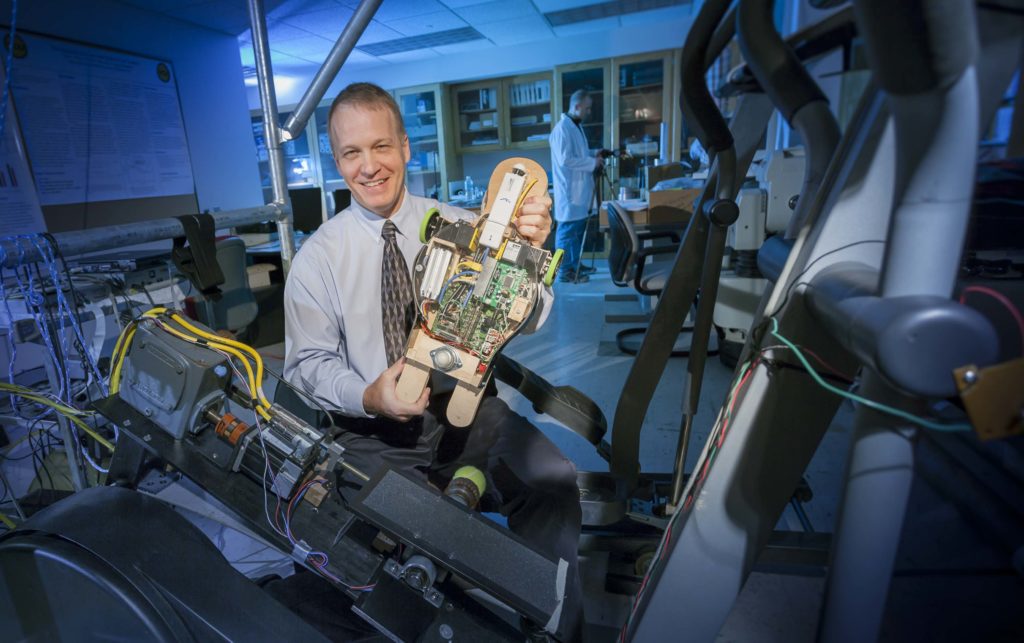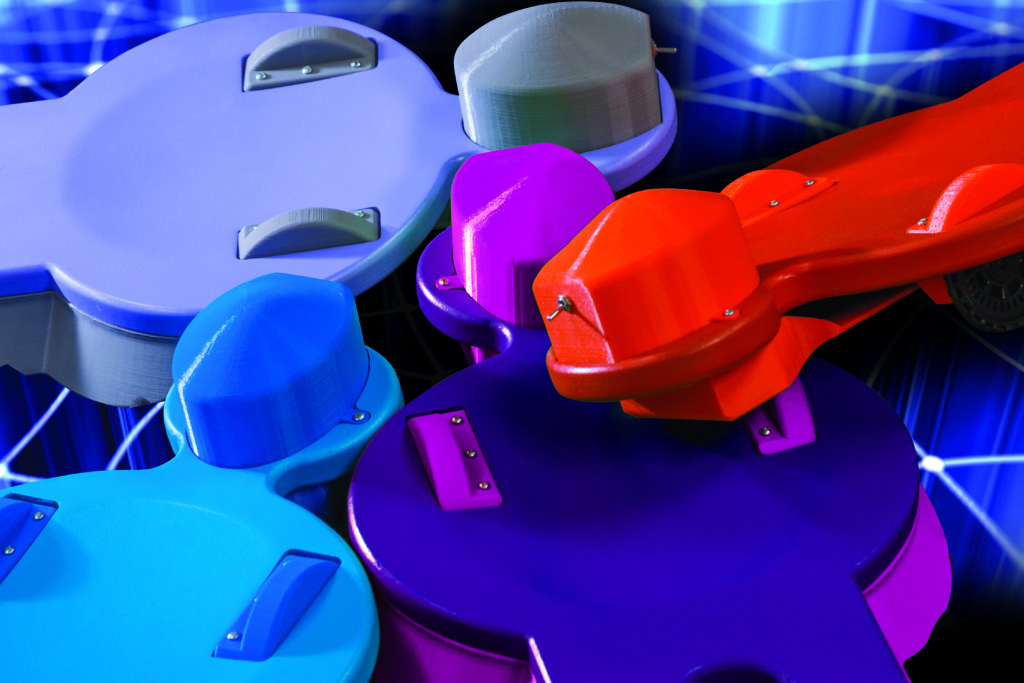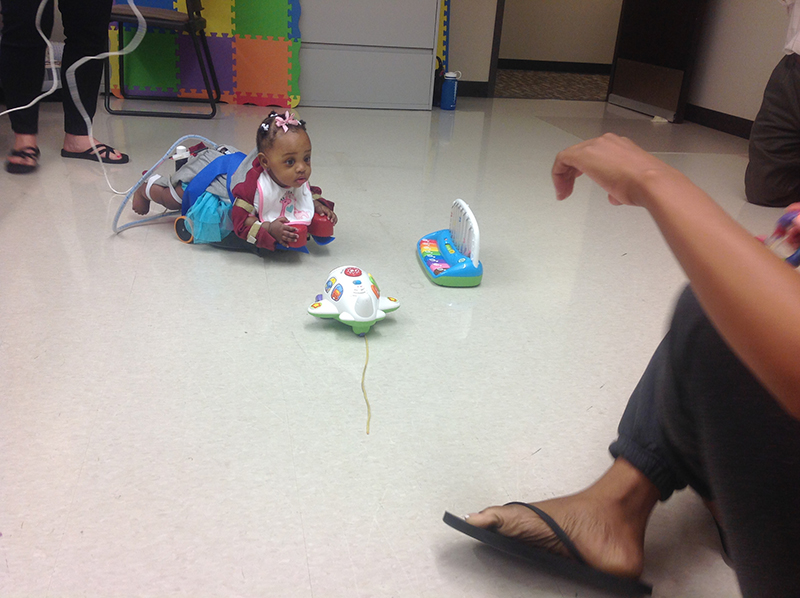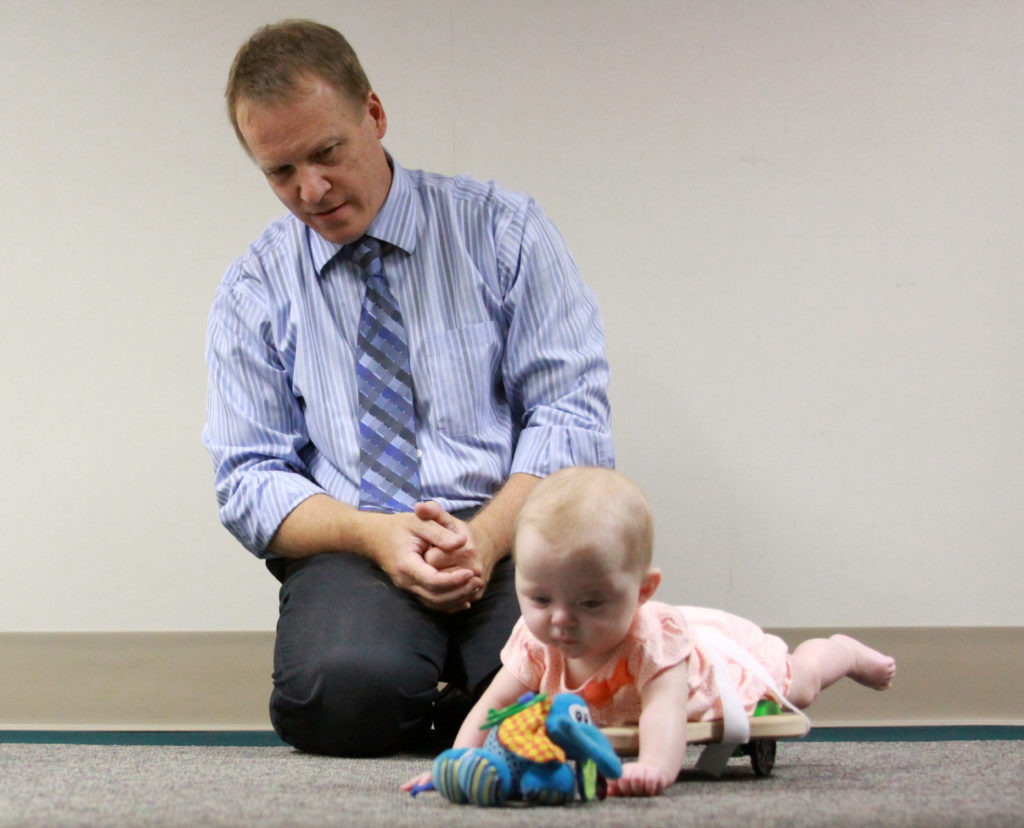Baby steps
Tuesday, February 28, 2017

A few years ago in Oklahoma, a mother playing with her 8-month-old twin daughters placed a toy on the ground. One of the sisters pulled herself to the toy, while the other focused on it and moved her arms and legs, but got nowhere.
The situation wasn’t surprising to the mother. She was already aware of the reason one of her daughters was unable to crawl: she had cerebral palsy.
In many cases, children with cerebral palsy and other neuromuscular disorders are challenged by lack of coordination or strength, preventing them from executing a coordinated crawling motion.
Overcoming this obstacle is important because there is more happening in a crawling baby’s brain than some might think. When children first begin to scoot, pull and slide from one curiosity to the next, they are discovering and grasping for knowledge, thus driving and promoting very critical cognitive and intellectual development during this early expression of inquisitiveness.
“Kids who don’t explore and interact with their environments—who don’t go out and taste the objects and do all of the things that kids do—can have delayed cognitive development,” says Peter Pidcoe ’97 BS PT, PhD, associate professor and assistant chair in the Department of Physical Therapy, Virginia Commonwealth University (VCU) School of Allied Health Professions. “There are age-critical benchmarks that need to be met in order to develop normally.”
This is the reality that one of the sisters in Oklahoma faced. Despite her desire to reach the toy, her muscles would not cooperate.

Creating the SIPPC
At a conference in 2004, Pidcoe connected with Thubi Kolobe, a professor in the Department of Rehabilitation Sciences at the University of Oklahoma, who worked on identifying infants who were likely to develop cerebral palsy or severe developmental delays. The earlier babies were identified, the sooner treatment could begin.
Unfortunately, treatment options that encouraged movement were limited. Kolobe wanted to tap into Pidcoe’s dual background in engineering and physical therapy to find a more effective way to promote developmentally appropriate movement in these infants.
“I saw these children kicking and swiping their arms, but as they grew older, they were losing these movements and falling behind,” Kolobe says. “I felt like the intervention that would help these babies had to somehow harness their early continuous movement and keep it going so they didn’t lose it.”
Pidcoe, who holds a Ph.D. in bioengineering and a B.S. in physical therapy from UIC, as well as a clinical doctorate in physical therapy from VCU, was the perfect person to collaborate with Kolobe.
Soon after their meeting, Pidcoe began developing a prototype for a motorized skateboard-type platform that would move babies, lying on their stomachs, from point to point. The initial prototype was clunky, but it was still a strong proof of concept.
Pidcoe and Kolobe were able to secure several grants to develop, revise and upgrade the platform using a uniquely designed series of studies. The device was labeled the Self-Initiated Prone Progression Crawler, or SIPPC.
Each study was a chance to refine the product. “On every iteration, and based on data collected from infants, we learned better ways to do this, like making it lower to the ground and reducing motor capacity,” Pidcoe explains.
By 2008, Pidcoe and Kolobe had arrived at the design and shape the SIPPC holds today. It has six different modes of operation depending on a baby’s needs, including mobility, force and gesture (see sidebar).
When the twin in Oklahoma who struggled to crawl was placed on the SIPPC, as she had been for several previous months while participating in research for the device, she “would straighten her arms out like an airplane and bring them back in [over and over again], and finally get to the toy,” Kolobe says.
The sisters—one on the SIPPC and one crawling—would even compete with each other. They were racing to the toy, their mother said. It was a competition she never thought she would see.
“When I saw that, I thought, ‘This is exactly what we want the SIPPC to do. To harness their movement efforts and allow the infants to get to where they want to go,’” Kolobe says. “Mobility in infants is a gateway to learning.”

How it teaches
This gateway to learning comes via reinforcement. The SIPPC harnesses, in various ways, a child’s movements that couldn’t normally propel them due to lack of coordination or strength. It then reinforces those movements by offering a reward in the form of advancing arbitrarily or toward a goal and eventual completion of that goal at some desired destination.
Learning to move the SIPPC happens slowly and by accident at first, but the babies do eventually repeat, “and if they repeat their arm and leg movements they don’t lose them,” Kolobe says. “That repetition builds the repertoire of movements needed for skills such as crawling, and they get better at it.”
The process is tied to cognition, motor learning and neuroplasticity. The babies must move intentionally in order to drive the SIPPC. Kolobe calls it a means to an end; if a baby can understand that she can use the SIPPC to attain her goals, she has successfully developed a cognitive skill.
“When babies are first introduced to the SIPPC, they don’t do a whole lot—they can be surprised and even disturbed by the action,” Pidcoe says. “They have to practice, but once they do, their exploration areas get larger and the amount of time they spend moving also increases.”

Creative exploration at UIC
In a certain sense, the roots of Pidcoe’s success with the SIPPC can be traced back to his rural childhood outside Philadelphia. He was a child who loved to take things apart and put them back together.
“The activities I did as a kid would probably get me on a list somewhere today,” he laughs. “Making fireworks, building rocket launchers—that kind of thing.”
Pidcoe’s natural curiosity carried through to adulthood, including during the final years of his bioengineering doctorate at UIC, when he started working with the Department of Physical Therapy. After graduation, he was brought on staff to launch the department’s Harry G. Knecht Movement Science Laboratory. Pidcoe’s engineering background was a good fit for faculty members who needed assistance building equipment for their research in muscle physiology, motor control and nerve regeneration.
“People used to joke about us being able to build something from nothing because we were on a shoestring budget,” Pidcoe notes. “When we couldn’t go out and buy the $20,000 device, we’d build our own for $3,000.”
While Pidcoe enjoyed the work, he tended to get antsy when he stayed in any job for too long. He started making plans to apply to medical school, thinking it would be helpful to diversify his bioengineering training with clinical studies. But fate intervened in the form of Jules Rothstein, then-chair of the Department of Physical Therapy, who convinced Pidcoe that he could pursue all the clinical courses he needed right there at UIC.
Pidcoe’s days soon centered on collaborative research in the Knecht lab, classes in the PT program and hands-on clinical work. Most students did three rotations of clinical work, but Pidcoe managed to do six.
“The PT staff was really great at accommodating my requests,” Pidcoe recalls. “I know it wasn’t easy to find all these different clinics to place me in.”
Pidcoe had taken many courses in anatomy, biology and kinesiology by that point, but the clinical rotations brought the textbook diagrams and classroom lectures to life. His stint at the Rehabilitation Institute of Chicago was particularly inspiring for the way it illuminated the intersections between bioengineering and rehabilitative physical therapy, paving the way for his current passion.
Today, he thinks of his overlapping interests as a giant 3-D Venn diagram. “I have information clouds in engineering, clinical medicine and physical therapy, and life experience,” Pidcoe explains. “Where the clouds intersect, that’s where you get the innovation and creativity.”

The SIPPC’s future
Those intersections also incorporate evolving technology. The SIPPC is now on its fourth iteration, and the design is “smaller, lighter and more useful,” Pidcoe says, in part due to technological innovations of the past few years. Pidcoe uses a laser cutter and 3-D printer to make each component.
“Not only does it cost less to make, but it has become really high-tech,” Pidcoe notes. He explains that the controller running the different modes can determine which system is working best for the child. “That’s useful data. It tells us how kids are evolving and which system they’re actually relying on.”
For example, if a physical therapist wants a child to work on a certain type of leg movement, the SIPPC can be programmed so it won’t move unless that movement is made.
Pidcoe receives calls every week from parents eager to purchase the SIPPC, and while it’s not available just yet, he’s optimistic about the its commercial viability. “The goal is that it will not only allow kids to get better on it, but also, that researchers will be able to do more work with it,” Pidcoe says. “We’re getting close.”
This article was adapted and edited with permission from Virginia Commonwealth University Public Affairs.